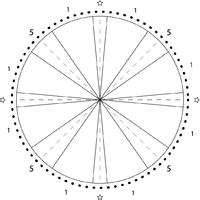antontalok
Newbie level 5
so, i want to make a running LED shaping a circle. just like arcade game which have many LEDs and they flash in turn.
i am planning to have about 65 LEDs
here is the picture how it's gonna look like.

i want those LEDs flash one by one.
and shape a circle
i want that done by several SIPO shift register. i think i might be using 74164.
i also have GAL as the decoder and logic gates.
when i press a button, the shift reg will start to turn on the LEDs, when i press the button again i want that LED stop at where i pressed the button.
there's point will earn to where it stop
i will have it accumulate by GAL and shown in two 7 segment.
and user is allowed to play three times only. (means three times to press the button start and stop).
the user should press Reset button provided.
and then so.
anybody could help me with this design?
\thanks
i am planning to have about 65 LEDs
here is the picture how it's gonna look like.

i want those LEDs flash one by one.
and shape a circle
i want that done by several SIPO shift register. i think i might be using 74164.
i also have GAL as the decoder and logic gates.
when i press a button, the shift reg will start to turn on the LEDs, when i press the button again i want that LED stop at where i pressed the button.
there's point will earn to where it stop
i will have it accumulate by GAL and shown in two 7 segment.
and user is allowed to play three times only. (means three times to press the button start and stop).
the user should press Reset button provided.
and then so.
anybody could help me with this design?
\thanks
Last edited:
